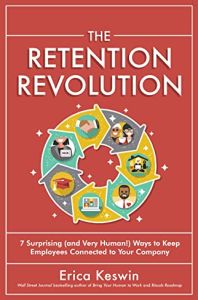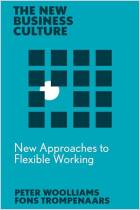Únase a getAbstract para acceder al resumen.

Únase a getAbstract para acceder al resumen.
Erica Keswin
The Retention Revolution
7 Surprising (and Very Human!) Ways to Keep Employees Connected to Your Company
McGraw-Hill, 2023
¿De qué se trata?
Adopt these seven human-centric strategies to keep your employees deeply connected and engaged.
Recommendation
Today’s workplace sometimes seems to feature a revolving door for employees moving from company to company. If you seek a cure for excess turnover, author Erica Keswin offers a human-centric approach to keeping employees invested in your company. Her seven strategic insights provide a refreshing perspective on the power of genuine connection in the modern workplace. Keswin’s compelling stories, real-world examples and ready-to-implement steps are designed to transform your retention rates. Whether you’re a seasoned leader or just starting, her manual can help you cultivate deeper, more meaningful bonds with your team.
Take-Aways
- Today’s revolving door reflects significant shifts in employees’ expectations of their employers and careers. To keep up, change seven outmoded practices:
- 1. Onboarding matters now. Make it the beginning of your new employees’ job, not just an administrative drill they have to check off.
- 2. Forget micromanagement. Give workers autonomy and flexibility.
- 3. Don’t cling to outmoded ideas about dress or personal expressions, like tattoos. Embrace individual authenticity at work.
- 4. Don’t schedule meetings for the sake of meeting; make sure your sessions have a clear purpose.
- 5. Don’t limit professional development to job-related tasks. Support employees’ careers and offer upskilling.
- 6. Instead of overlooking your managers, celebrate them.
- 7. Don’t just show employees the door; create a positive exit experience. They may come back.
Summary
Today’s revolving door reflects significant shifts in employees’ expectations of their employers and careers. To keep up, change seven outmoded practices:
Career-long job stability, once provided by giant corporations such as IBM and General Motors, is now almost obsolete. The drivers behind this shift are not just global events such as the COVID-19 pandemic but also underlying economic changes. Take the rise of the gig economy, which has empowered workers with flexibility and choice. In a recent survey, 80% of respondents said they would not hesitate to leave a job within six months of being hired if it failed to meet their expectations. A report from Grant Thornton further revealed that roughly 4.5% of today’s new hires are people who worked for that same company at some point in the past.
“Leaders, employers, journalists and experts have been pointing to this talent upheaval as one of the biggest challenges companies have ever faced.”
In this new environment, companies need more agile hiring and retention strategies. Firms that prioritize employee well-being, such as those on the “Fortune 100 Best Companies to Work For” index, achieve better financial performance, significantly outpacing the broader market. To capitalize on the cyclical nature of today’s workforce, shift away from seven outmoded ideas derived from outdated linear work models. Update your practices in onboarding, worker autonomy, the definition of professionalism, meeting management, professional development, the role of managers and even how employees exit. The seven shifts are:
1. Onboarding matters now. Make it the beginning of your new employees’ job, not just an administrative drill they have to check off.
The old idea that onboarding is not “real” work but an administrative hurdle employees must overcome isn’t useful in today’s fast-paced hiring environment. Onboarding provides a crucial time to set the tone for what’s to come in an employee’s life in your organization. People need to feel welcomed into the community. Onboarding should give them a firm grasp of the company’s culture and values. When this doesn’t occur, disengagement often follows – as happened with a large media company’s new recruit who reported feeling “invisible” because no one announced his arrival during his entire first week.
“Start as you mean to go on.”
Think of onboarding as the commencement of a mutually beneficial, dynamic relationship between employer and employee. Realize, as LinkedIn co-founder Reid Hoffman said, that modern employees aren’t signing up for a lifetime with your company, but, rather, a “tour of duty.” They expect to move on at some point, but also, possibly, to return if they have a good experience. By ensuring new hires connect with their coworkers and the corporate culture from the start, you increase the likelihood that new employees will see their job as more than a set of transactional activities.
Three “P’s” guarantee onboarding success:
- Be Professional – One person should have the sole responsibility of onboarding new hires. That employee’s goal is to make sure onboarding is uniform and feels intentional.
- Be Personal – Create avenues of communication, such as one-on-one meetings or phone calls – that make it possible for new hires to express their values, vulnerabilities and needs while they are employed by your organization.
- Be Purposeful – Define your intentions going into the onboarding process. Delineate which company values you want new hires to know, which people in the organization will be most helpful to them, and what tasks or responsibilities they should prioritize.
If you are the leader of your company, evaluate your organization’s onboarding program, starting when you offer a job. Consider onboarding new hires in groups for mutual support. The onboarding process should align with your corporate values, involve pivotal personnel, offer regular touch points beyond the first day and provide an avenue for continual feedback.
2. Forget micromanagement. Give workers autonomy and flexibility.
The pandemic changed the office environment forever and revealed to workers that remote work is not only possible but, for many, preferable. Today’s workers often want to work from home because they value flexibility and autonomy – and, as Georgetown University professor Nick Lovegrove argues, many workers dislike traditional office environments. A 2022 Monster Work Watch Report made this sentiment evident when it found that 26% of respondents would rather undergo a painful dental procedure than work in their offices five days a week.
The old idea that managers need to see their employees working constantly no longer holds true. For instance, Sid Sijbrandij, the CEO of GitLab, one of the largest remote-based companies, says he measures his employees by their results, provides sufficient freedom and autonomy to shape their own schedule, and then benefits from happy, balanced and highly productive workers.
“In other words, when productivity is understood as time spent instead of results delivered, you miss the point entirely.”
Companies should assess their current policies on flexible work, considering the needs of diverse groups, including women, caregivers and people of color. Focus on obtaining measurable results and building trust rather than obsessing over the employee’s activities. When you invite an employee to visit your office, have a clear purpose, so you foster collaboration and meaningful connections. Provide guidelines for flexible work arrangements. Perhaps you can set core work hours but remain open to experimentation, continuous feedback and strategic adjustment as needed.
3. Don’t cling to outmoded ideas about dress or personal expressions, like tattoos. Embrace individual authenticity at work.
The shift to remote work has blurred the lines between people’s professional and personal lives. For many, this change has led to increased efficiency. In a study from the WFH Research project, remote workers claimed they experienced a 9% increase in their efficiency at home compared to being in the office. Workers have also been redefining the concept of “professionalism” to prioritize personal authenticity and psychological safety over outward appearances. This push to rethink traditional standards of what constitutes professional dress and behavior coincides with broader shifts in perception.
A 2022 study in The Journal of Organizational Behavior revealed that, unlike in the past, many customers no longer view tattooed employees negatively. This is especially true of those in artistic, white-collar jobs. Major healthcare organizations such as Indiana University Health and the Mayo Clinic have updated their policies to allow visible tattoos, acknowledging that around 47% of US millennials have at least one tattoo.
“Creating an inspiring space for the human professional comes down to paying attention to how we dress and express for truly human success.”
With members of gen Z entering the workforce and millennials moving into managerial positions, companies must embrace the authentic way people present themselves. Companies should review and update their workplace dress codes and policies about self-expression to make sure they’re inclusive and not biased. Foster a safe environment where employees can express themselves freely.
4. Don’t schedule meetings for the sake of meeting; make sure your sessions have a clear purpose.
The pandemic generated support for asynchronous work, “a method of exchanging information without the expectation of real-time feedback.” Advocates emphasize its benefits in reducing unnecessary meetings and promoting more focused, individualized work. Purposeless meetings have a strong correlation with job dissatisfaction. Many workers agree that “70% of all meetings are a waste of time,” suggesting managers need to rethink the frequency and purpose of such gatherings. Companies such as GitLab, a major all-remote employer, that have started embracing asynchronous work have seen improvements in cross-functional communication across the board.
“The more focused and particular a gathering is, the more narrowly it frames itself and the more passion it arouses.” (author Priya Parker)
To avoid meeting solely for the sake of meeting, structure each meeting with these three points in mind:
- “Purpose” – Every meeting must have a direct intent. Don’t have the meeting if you can’t articulate why you’re calling people together.
- “Presence” – Whether you meet virtually or in person, remember the participants are real people who have taken the time to sit down with you. Be respectful and give them your full attention.
- “Protocol” – Develop clear meeting guidelines that resonate with your company’s values. Be deliberate in determining meeting frequency, participants and structure. Turn effective practices into regular habits.
Less is more when it comes to meetings. Employees respond better, engage more deeply and feel less drained when they don’t have as many meetings to attend.
5. Don’t limit professional development to job-related tasks. Support employees’ careers and offer upskilling.
Taking professional development personally is crucial for employee retention and engagement. A lack of development opportunities is one of the primary reasons people leave their employers. Awareness and support for internal career progression can lead to 30% to 50% higher engagement and retention rates. Moreover, upskilling existing employees is more cost-effective than rehiring, giving you a competitive advantage. From a diversity, equity and inclusion perspective, offering accessible professional development is essential to attract and retain diverse talent. Members of under-represented groups often feel less satisfied with their employer’s development opportunities.
The Chipotle restaurant chain stands out for its exceptional commitment to professional development. It offers such perks as a free college education in various fields, stipends for educational programs, and benefits such as free therapy and meals. Employees can attain a four-year degree through Chipotle’s partnerships with accredited institutions and remain debt-free after graduation, with no obligation to stay with the company. This investment in employee growth has resulted in increased retention and more internal promotions. Chipotle’s management understands that nurturing its workforce fosters a positive culture and strong brand ambassadors.
To make the most out of professional development and to encourage retention, companies should prioritize employees’ growth by accessibly listing available development opportunities to emphasize that continuous growth is a competitive edge. Companies should encourage managers to discuss and support their team members’ growth plans. Make sure growth opportunities are accessible during working hours, including online courses, workshops or internal training. Finally, integrate professional development from the onset of an employee’s journey, starting during onboarding. Offering these opportunities with no strings attached can result in long-term benefits, including providing an incentive for former employees to return to the company and generating new business opportunities.
6. Instead of overlooking your managers, celebrate them.
A good or bad manager can make or break an employee’s whole experience at a company. Thus, executives need to give more attention to their hiring choices when they recruit new managers. Melissa Werneck, global chief people officer at Heinz, warns that only one in 10 people are naturally fit to manage others.
“As individual contributors, managers have an outsized impact on the state of your workforce, so… focus on their training and feedback… to keep your company healthy.”
The role of managers is crucial, especially as the definitions of work and the employee journey evolve. Simply placing individuals in managerial roles based on their proficiency in their day jobs or availability can be short-sighted. Instead, treat managerial positions with the seriousness they deserve. For example, despite its significant growth during the pandemic, Squarespace recognized the challenges of rapidly promoting people with expertise in their fields but limited managerial training. Andrew Stern, the head of manager development, emphasizes the company’s commitment to upskilling new managers and training their superiors in the best ways to support them.
Elevate the process of becoming a manager by providing structured, professional, and branded experiences that align with the company’s mission. Additionally, your firm can celebrate managers by creating connected communities where they can learn and grow together.
7. Don’t just show employees the door; create a positive exit experience. They may come back.
Creating a positive exit experience is pivotal for modern companies. Evidence suggests that a significant 28% of new hires over a three-year period are actually returning employees or “boomerang” hires. The underlying reasons employees return include unmet expectations at new workplaces and the enduring strength of social ties formed at their prior jobs. Moreover, the way companies handle an exit resonates profoundly. Psychologist Daniel Kahneman’s peak-end rule theory posits that people often remember experiences in terms of their concluding moments. A positive farewell bolsters the departing employee’s perception of the company (and, perhaps, supports a future decision to return) and influences the morale of those who remain.
“Smart companies know how to get a positive return on employee churn.”
To create a successful exit experience for departing employees, recognize that employees often view their tenure at your company as just one chapter in their broader career. However, fostering a supportive environment can lead them to return, not only as employees but also as clients or referrers. Second, companies must actively promote internal growth opportunities to reduce unnecessary turnover and its associated costs. Finally, launching a robust alumni employee program and cultivating a graceful leave policy can build trust, facilitate better planning, and sometimes even present alternative solutions for those considering departure.
About the Author
Author Erica Keswin is a business strategist with over 25 years of experience.
This document is restricted to personal use only.























Comment on this summary